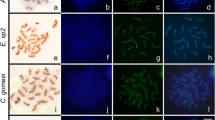Abstract
. The oocytes of a 17 week human fetus carrying an unbalanced 46,XX,add(18)(p13) translocation were studied with a sequential combination of microspreading, immunocytogenetics, fluorescence in situ hybridization (FISH) and transmission electron microscopy. This combination of technologies allowed the collection of data of unique accuracy and resolution. The translocated chromosome was found to be involved in five different synaptic configurations. A consistent feature of these configurations was the involvement of a second small bivalent, presumably chromosome 21 or 22, the normal synapsis of which was often disrupted. We conclude that chromosome 21 or 22 was the source of the translocated material, which was found to be either homologously triply synapsed, heterologously synapsed or asynapsed.
Similar content being viewed by others
Author information
Authors and Affiliations
Additional information
Received: 31 August 1996; in revised form: 1 April 1997 / Accepted: 24 May 1997
Rights and permissions
About this article
Cite this article
Barlow, A., Hultén, M. Sequential immunocytogenetics, molecular cytogenetics and transmission electron microscopy of microspread meiosis I oocytes from a human fetal carrier of an unbalanced translocation. Chromosoma 106, 293–303 (1997). https://doi.org/10.1007/s004120050250
Issue Date:
DOI: https://doi.org/10.1007/s004120050250




